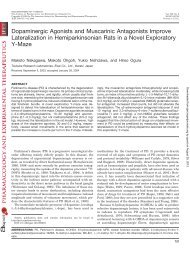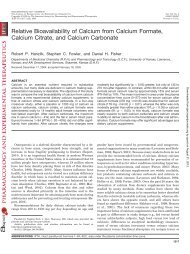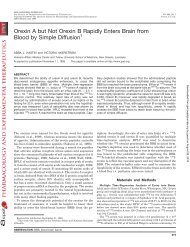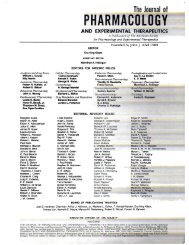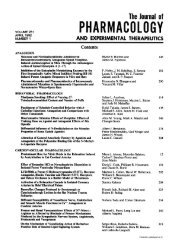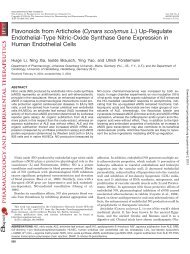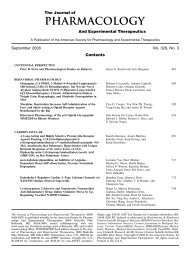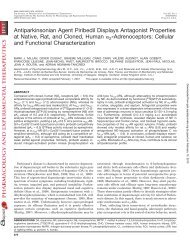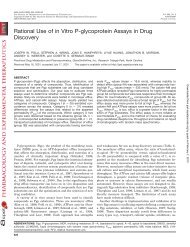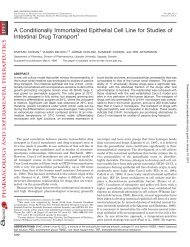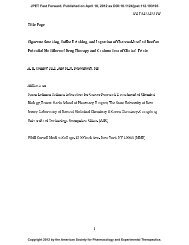A-770041, a Novel and Selective Small-Molecule Inhibitor of Lck ...
A-770041, a Novel and Selective Small-Molecule Inhibitor of Lck ...
A-770041, a Novel and Selective Small-Molecule Inhibitor of Lck ...
You also want an ePaper? Increase the reach of your titles
YUMPU automatically turns print PDFs into web optimized ePapers that Google loves.
40 Stachlewitz et al.<br />
TABLE 2<br />
Serum concentrations <strong>of</strong> A-<strong>770041</strong> in the 14-day transplantation study<br />
Serum concentrations <strong>of</strong> A-<strong>770041</strong> were measured as described under Materials <strong>and</strong><br />
Methods. Data are presented as mean S.D. (n 6).<br />
Study Day<br />
C 12h<br />
2.5 mg/kg/day 5 mg/kg/day 10 mg/kg/day 20 mg/kg/day<br />
nM<br />
Day 0 128 18 217 55 574 114 994 174<br />
Day 3 222 63 581 236 1467 446 3133 1583<br />
Day 7 278 58 526 35 1369 848 3072 1300<br />
Day 14 191 29 343 130 1065 224 2963 1583<br />
Fig. 6. Histology <strong>of</strong> transplanted heart grafts at 65 days after transplantation.<br />
Recipient Lewis rats were treated with A-<strong>770041</strong> (10–20 mg/kg/<br />
day) or Cyclosporin A (10 mg/kg/day) starting the day before surgery <strong>and</strong><br />
for 65 days after transplantation <strong>of</strong> a heart from a Brown Norway donor.<br />
Sections <strong>of</strong> the transplanted graft were collected <strong>and</strong> processed as described<br />
under Materials <strong>and</strong> Methods. A <strong>and</strong> B, A-<strong>770041</strong>, 10 mg/kg/day;<br />
C <strong>and</strong> D, A-<strong>770041</strong>, 20 mg/kg/day; E <strong>and</strong> F, Cyclosporin A, 10/mg/kg/day.<br />
A, C, <strong>and</strong> E, low magnification; B, D, <strong>and</strong> F, high magnification. ,<br />
representative areas <strong>of</strong> inflammation; e, representative areas <strong>of</strong> edema.<br />
mg/kg/day Cyclosporin A (E <strong>and</strong> F) had minimal multifocal<br />
mononuclear infiltrates in allografts (arrows). The allografts<br />
from animals dosed with 10 mg/kg/day A-<strong>770041</strong> had an<br />
increased incidence <strong>of</strong> minimal vascular changes characterized<br />
by tunica media hypertrophy, vacuolated myocytes, <strong>and</strong><br />
reactive endothelial cells (vessel, Fig. 6B) compared with the<br />
Cyclosporin A or 20 mg/kg/day A-<strong>770041</strong> groups. In addition,<br />
one graft from the 10 mg/kg/day A-<strong>770041</strong> group had minimal<br />
vasculitis (data not shown). There was also increased<br />
incidence <strong>of</strong> minimal edema (e) within the 10 mg/kg/day<br />
A-<strong>770041</strong> <strong>and</strong> 10 mg/kg/day Cyclosporin A groups. Mineralization<br />
was present in allografts from the Cyclosporin A<br />
group, with minimal to mild scores in three <strong>of</strong> five allografts<br />
but was not seen in grafts from animals treated with<br />
A-<strong>770041</strong> (data not shown). In addition, allografts from the<br />
Cyclosporin A group had neovascularization extending intramurally<br />
from the pericardium.<br />
Discussion<br />
A-<strong>770041</strong> is a selective inhibitor <strong>of</strong> <strong>Lck</strong> that shows comparable<br />
efficacy with Cyclosporin A in preventing acute transplant<br />
rejection in solid organs. This compound has prototypical<br />
activity <strong>of</strong> an immunosuppressive agent by blocking T<br />
cell activation <strong>and</strong> IL-2 production in vitro <strong>and</strong> in vivo. Pharmacokinetic<br />
data show that A-<strong>770041</strong> is amenable to chronic,<br />
oral, twice daily dosing in rats with compound reaching a<br />
steady-state C 12h in blood by day 3 <strong>and</strong> maintaining it<br />
through day 65. Oral doses <strong>of</strong> A-<strong>770041</strong> at 10 <strong>and</strong> 20 mg/kg/<br />
day prevented acute rejection for 65 days after transplantation,<br />
at which point the experiment was concluded. The 10<br />
mg/kg/day dose limited rejection but did not completely prevent<br />
the infiltration <strong>of</strong> mononuclear cells into the allograft.<br />
These data show that a specific inhibitor <strong>of</strong> <strong>Lck</strong> is efficacious<br />
in preventing acute rejection in a rodent model.<br />
The serum concentrations <strong>of</strong> A-<strong>770041</strong> measured in the<br />
dose-response experiments <strong>of</strong> concanavalin A-mediated IL-2<br />
production in vivo compared with the results <strong>of</strong> 14- <strong>and</strong><br />
65-day transplantation studies provide some interesting predictions<br />
concerning the efficacious plasma concentrations <strong>of</strong><br />
A-<strong>770041</strong> needed to prevent acute rejection. One hundred<br />
percent survival <strong>of</strong> grafts at either 14 or 65 days after transplantation<br />
only occurred when the C min concentrations for<br />
A-<strong>770041</strong> were maintained above the EC 90 for inhibiting IL-2<br />
production in vivo. This point is most clearly illustrated by<br />
the lack <strong>of</strong> efficacy <strong>of</strong> A-<strong>770041</strong> when dosed at 2.5 <strong>and</strong> 5<br />
mg/kg/day. In both <strong>of</strong> these treatment groups, the C min serum<br />
concentrations are well below the EC 90 for inhibition <strong>of</strong><br />
concanavalin-A-induced IL-2. These data suggest, similar to<br />
the data published with Cyclosporin A, that IL-2 production<br />
must be nearly maximally inhibited to prevent acute rejection<br />
<strong>of</strong> transplanted organs.<br />
<strong>Lck</strong> is an attractive target to block T cell activation for a<br />
number <strong>of</strong> reasons (Tsutsui et al., 2003). First, <strong>Lck</strong> is crucial<br />
in the activation <strong>of</strong> T cells causing clonal expansion <strong>and</strong><br />
generation <strong>of</strong> a cytotoxic T cell response (Weiss <strong>and</strong> Littman,<br />
1994). Second, it is expected that inhibitors <strong>of</strong> <strong>Lck</strong> should<br />
prevent rejection <strong>of</strong> transplanted organs as evidenced by<br />
prolonged skin allograft survival in <strong>Lck</strong> / mice (Wen et al.,<br />
1995). The data presented here <strong>and</strong> in a previous publication<br />
with a first generation <strong>Lck</strong> inhibitor (A-420893) show the<br />
potential <strong>of</strong> an inhibitor <strong>of</strong> <strong>Lck</strong> to prevent acute rejection<br />
(Waegell et al., 2002; Borhani et al., 2004).<br />
In addition, the expression <strong>of</strong> <strong>Lck</strong> is thought to be limited<br />
to T cells, natural killer cells, B1 cells, <strong>and</strong> heart, brain, <strong>and</strong><br />
retinal neurons (Omri et al., 1998; Ping et al., 2002). Although<br />
expression <strong>of</strong> <strong>Lck</strong> in the brain <strong>and</strong> heart has been<br />
reported, <strong>Lck</strong> / mice have not been reported to have any<br />
cognitive or cardiovascular deficits. The only reported detrimental<br />
effect <strong>of</strong> knocking out <strong>Lck</strong> in nonimmune tissues is<br />
retinal dysplasia <strong>and</strong> retinal detachment (Omri et al., 1998).<br />
Whether this is a developmental or functional defect from the<br />
lack <strong>of</strong> <strong>Lck</strong> expression will need to be explored with potent,<br />
selective inhibitors <strong>of</strong> <strong>Lck</strong> such as A-<strong>770041</strong>.<br />
Downloaded from<br />
jpet.aspetjournals.org by guest on May 29, 2013



